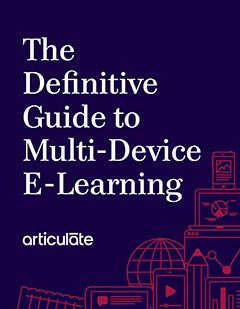Rise 360: How to Use Button Blocks
Article Last Updated
This article applies to:
When you use buttons in Rise 360, learners can access external information easily, send emails, and quickly jump to other spots in the course.
Here’s how they work.
- Insert a Button Block
- Edit Button Block Text
- Choose a Destination
- Modify Button and Block Settings
- Accessibility Information
Step 1: Insert a Button Block
- Open a Rise 360 course, then edit an existing lesson or create a new one.
- Click All Blocks in the blocks shortcut bar or the insert block icon that appears when you mouse over a boundary between blocks.
- From the sidebar, select the Interactive category, then, depending on how many buttons you need, click Button or Button stack in the panel.
You can switch an existing block between a single button and a button stack using the left-hand drop-down list. If you need to delete a button from a stack, click the Content button to open the sidebar, then click the trash icon that appears when you hover over the button’s details.
Step 2: Edit Button Block Text
Edit the heading and description to the left of your button in the body of your Rise 360 course or in the sidebar. Button labels can only be edited in the sidebar.
- From an existing button block, click the Content button in the design toolbar or click the button whose label you want to change.
- Enter text in the Label field to modify the text of your button.
- Use the Description field to modify the descriptive text that displays next to your button.
Step 3: Choose a Destination
Buttons can link to an external webpage, an email address, or an internal location in your course. You can also modify them to let learners in LMS courses exit the course altogether.
For all of these options, click the Content button or click the button whose destination you want to change.
Link to an External Webpage
- Choose Link to a webpage from the Destination drop-down list.
- Enter the URL address of the page to which you’d like to link.
When learners click the button, a new tab will open in their browser and take them to the specified webpage.
Link to a Relative URL
- Choose Link to a relative URL from the Destination drop-down list.
- Enter the URL address of the page within your subdomain to which you’d like to link.
When learners click the button, a new tab will open in their browser and take them to the specified webpage. This webpage must be within your subdomain.
Send an Email
- Choose Send an email from the Destination drop-down list.
- Enter the email address in the field that appears. Have multiple email addresses you’d like to link to? Just separate them with commas.
When learners click the button, a new draft email to the address(es) you specified is created by their default installed email application. The email subject line will be the name of the course.
Note: While it's possible, through the use of browser extensions and advanced settings, to open mailto links in web-based email clients such as Gmail, most learners will need an email application installed on their device.
Navigate to Another Lesson
Simply choose the title of the lesson from the Destination drop-down list. Clicking this button will smoothly take learners to the destination lesson on the same screen as if it were in-line content.Close the Course
This destination type only works in LMS courses. Choose Exit the course (LMS only) from the Destination drop-down list.
Clicking the button in an LMS course lets learners exit the course entirely.
Step 4: Modify Button and Block Settings
Buttons use your theme color by default. Click the Format icon in the left-hand design toolbar to access button color formatting. Here you can enter a hex code or choose a color manually and click Done to apply.
Click Reset to switch back to the theme color. To re-apply your previously selected custom color, open the color window and click Reset.
When you select a custom color, text contrast options display. Text contrast defaults to auto, maintaining an accessibility-conformant 4.5:1 ratio, but you can also select light or dark options. Light and dark contrast options may not maintain accessibility conformity.
Customize block settings to modify how the block displays.
Accessibility Information
Button blocks are mostly accessible. Currently, there is no option to customize the size or color of the button text. Verify the contrast conforms to accessibility guidelines with the white text on the buttons. Additionally, conduct testing with keyboard navigation and screen readers.
Looking for more accessibility design tips or resources? Check out the following:


